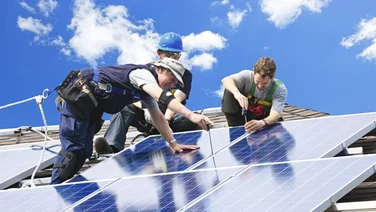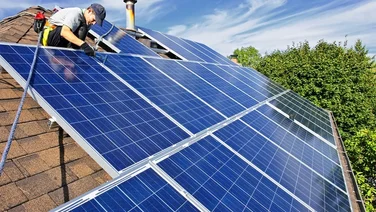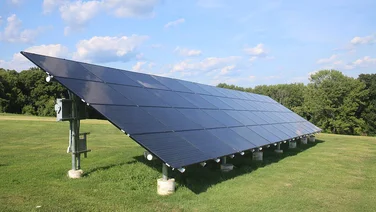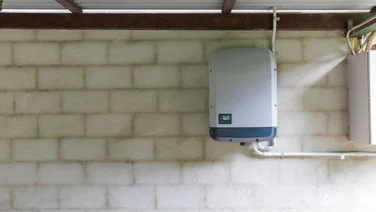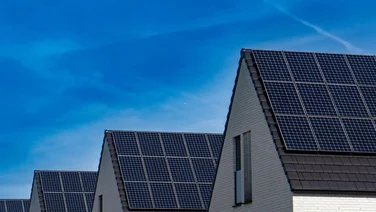- Ripple Energy aims to help people make money while cutting their energy bills
- You can get started by paying a reservation fee of just £25
- The more shares in a project you buy, the cheaper your electricity will be

Ripple Energy is an emerging renewable energy developer that offers an innovative way for consumers and businesses to invest in large-scale clean energy projects in exchange for access to affordable green electricity.
With its unique cost-saving and eco-friendly features, Ripple appeals to both experienced investors and green-minded consumers. But, like any investment, there are risks and uncertainties.
Whether you’re a conscious investor or simply looking for a better way to reduce your energy bills, this Ripple Energy review will tell you everything you need to know about investing in Ripple.
What is Ripple?
Ripple is a UK-based company that aims to make renewable energy ownership available to everyone at an affordable price. The scheme is for anyone who wants to help the planet while saving money on their energy bills, and is an alternative to the upfront cost of owning your own tech, like solar panels.
“Since 2017, our mission has been to make green energy ownership simple, affordable and accessible to everyone, everywhere,” Sarah Merrick, CEO of Ripple Energy told us.
When you buy shares in a Ripple Energy project – i.e., one of the solar parks or wind farms – and join the Ripple co-operative, you own a piece of a renewable energy project that gives you cheaper green electricity through one of the company’s energy partners.
Your investment pays for the construction of the wind farm or solar park, which Ripple manages. Once the project completes and starts generating electricity, you’ll have your own dashboard to track your electricity consumption, CO2 output, and savings.
It’s a simple and straightforward process that puts you in control of your energy usage and its impact on the environment.

Ripple projects
Graig Fatha Wind Farm: Ripple’s flagship project near Coedely in south Wales, launched in March 2022. The wind farm has one 2.5 megawatt (MW) wind turbine, which helped cut its 900 owners’ electricity bills by an average of £977 in 2023.
Merrick describes the Graig Fatha wind farm project as “a huge success”, saying that renewable energy projects are vital to increasing the UK’s energy security and reducing our reliance on fossil fuels.“Demand to own a source of green energy is only increasing, as is evident from thousands of people registered with Ripple for priority access to our next project when it’s announced,” Merrick says.
“People are at the heart of Ripple and the driving force behind our mission. Anyone can join this journey, secure in the knowledge that great things are achieved by working together.”
Furthermore, Merrick says Ripple Energy hopes to launch “multiple projects each year” and is aiming to launch its first project outside the UK in 2025.Other projects include:
- Kirk Hill Wind Farm: Ripple’s second wind farm project in Ayrshire, west Scotland, is due to launch in early 2024. This wind farm will have eight 2.35 MW turbines, generating up to 18.8 MW – potentially enough power for 20,000 homes.
- Derril Water Solar Park: Ripple’s first solar park project in north west Devon, England, is expected to launch in the summer of 2024. This solar park will have at least 70,000 panels generating up to 42 megawatts peak (MWp) – potentially enough electricity for 14,000 homes.
How much money can I save by investing in Ripple?
Your Ripple investment can give you significant savings on your energy costs, but it all depends on factors such as the size of your home, your energy consumption habits, and how much you put in upfront.
Additionally, Merrick says savings “depend on future electricity prices” and that “the higher future prices are, the greater the potential project savings”.
If you invest enough to cover 100% of your home’s electricity use, Ripple estimates that you could save up to 25% on your yearly bills.
Invest enough to cover 120% of your home’s annual electricity consumption and you’ll save a minimum of around £200 per year, on average.
When will I start getting cheaper electricity?
The timeline for when you’ll start seeing cheaper electricity from your Ripple investment isn’t set in stone, as it largely depends on when the wind farm or solar park you’ve invested in is up and running.
Renewable energy projects involve a significant amount of planning, construction and regulatory approvals, which can take up to two years. But once the project is fully operational, you’ll start seeing the benefits on your electricity bills.
Keep in mind that wholesale electricity prices will affect your savings, and these can fluctuate depending on supply and demand and wider economic changes (for example, during geopolitical conflicts, such as the war in Ukraine).
Higher electricity prices will mean more savings on your bill.
What happens if my shares generate more electricity than I can use?
The electricity generated from your Ripple shares acts as a credit for your electricity bill. That means, if you generate more electricity than you can use each month, you won’t lose out on any benefits.
Any surplus credit applies to your future bills instead, reducing the amount you have to pay. The more electricity your shares generate, the more potential savings you can enjoy for longer.
How do I invest in Ripple?
Investing in Ripple is really straightforward. Here are the steps you need to follow:
- Choose a project: Ripple offers various wind farm and solar park projects, though not all are open for investment. You can get access to the next open project by paying a £25 reservation fee to hold your place in the queue.
- Read the share offer document: Once a project is open for investment, Ripple will publish a share offer document outlining the costs of the shares and the relevant fees. Make sure you review the terms before converting your reservation.
- Decide how much to invest: The more you invest, the bigger your share in the renewable energy project – and the higher your savings on your electricity bills. You can invest up to 120% of your annual household consumption.
- Buy your share: Once you’ve decided on the amount, you’ll pay a one-off cost to join the project co-operative as an investor member. The co-operative funds and owns the construction of the renewable energy project.
- Check your energy supplier: If your current energy supplier isn’t a Ripple partner, you’ll need to switch to one of Ripple’s approved partners to use the service. There’s a range of partners to choose from, including Octopus, E.ON Next, and others.
- Enjoy the benefits: Once your project is operational, the energy it generates will start offsetting your energy bills. You can keep track of your electricity generation and bill savings on your personal member’s dashboard – if your share generates more power than you use, the surplus rolls over to your future bills so you’ll always benefit.
Remember, investing always comes with risks, so it’s important to do your due diligence before making any investment decisions.
How much does it cost to invest in Ripple?
The more of the green energy project you want to own, the higher the Ripple Energy share price will be. Use the Ripple Energy calculator to estimate the cost of owning enough to cover your electricity consumption.
For instance, a quote for a typical three-bedroom home consuming 2,700 kilowatt-hours (kWh) annually recommends buying 1,102 Watts (W) of the project for £1,902, which should cover roughly 100% of the electricity consumed.
On top of these one-off project costs, Ripple charges an arrangement fee and a £25 reservation fee, paid when you reserve your place in a project. You’ll find the specific costs for the project in its share offer document once it’s open – it’s crucial to read this properly before converting your reservation into shares.
How much can I buy?
You can buy as little or as much as you want, up to 120% of your usual household consumption. For instance, if your home typically consumes 3,000 kWh of electricity per year, you could buy shares that generate up to 3,600 kWh annually.
This approach guarantees you won’t run out of savings if you use more. Any surplus electricity will be credited to your future bills, so it’s a win-win.
What is the payback period with Ripple?
The payback period is essentially the time it takes for your investment to pay for itself. With Ripple, the payback period largely depends on the specific project you invest in and can vary significantly based on the wholesale price of electricity.
When the price of electricity is high, the savings on your electricity bills will be higher, leading to a shorter payback period. But when the price of electricity is lower, the savings would be lower too, resulting in a longer payback period.
Does joining Ripple get me free electricity?
Sadly, joining Ripple doesn’t mean you’ll get free electricity. Your share of power generated offsets your electricity usage, so you pay less. But you’ll still have to cough up for the chunk of non-electricity costs on your bill.
These costs include taxes and fees for using the national grid, which are usually passed on to consumers through bill levies.
Can I keep my Ripple investment if I move home?
You can keep your Ripple investment even if you move. It’s not connected to your home, but to you as an individual, which means your investment stays with you, regardless of where you live.
But don’t forget to let your new energy supplier (who should also be a Ripple partner) know about your move so they can apply the benefits of your Ripple investment to your new electricity bills.
Can I still join if I’m not with one of the approved partners?
You can join Ripple even if you’re not with one of their approved partners, but you’ll eventually need to switch before the project energisation date. This is because Ripple works with certain energy suppliers to make sure the electricity from your shares counts towards your bill.
That said, you’re not obligated to sign up with any particular partner. Ripple provides unbiased information about their supply partners and tariffs, so you can make an informed choice.
The switching process is generally straightforward and can often be completed online. Once you’ve switched, you can then start offsetting your electricity consumption with the electricity generated from your shares.
Can I sell my Ripple shares?
“Members cannot sell their shares, however, if they no longer want to own part of a project, they can request to withdraw their membership,” Merrick says.
“Ripple will then seek to match their request with other members looking to increase their ownership.
“Memberships cannot be withdrawn until the project has been operating for two years.
Only a few members have withdrawn their membership for reasons such as moving abroad.”
Can I buy more shares?
You can purchase more shares in Ripple renewable energy projects from your Ripple account dashboard, but availability depends on project capacity.
You can only buy more shares when a new project starts or when there are more watts available in existing projects. So there’s no guarantee you’ll be able to buy additional shares, as it depends on the demand from other investors.
Ripple periodically launches new wind and solar projects, but each of these projects has a limited number of shares that can be owned. There may also be a long wait for an existing investor to withdraw from a project.
Summary: Is Ripple worth it?
- Ripple allows you to buy shares in renewable energy projects. By investing, you contribute to renewable energy, potentially lower your electricity bills, and support a low-carbon economy.
- The investment cost depends on the number of shares you buy, with each share representing a certain amount of watts in a project.
- If your current supplier isn’t a Ripple partner, you’ll have to switch to one before your renewable energy project becomes operational.
- The payback period depends on factors like the cost of shares, electricity generated by your shares, and the price of electricity.
- You can buy more shares via your Ripple account, subject to availability. You can’t sell your shares, but you can withdraw your investment under certain conditions.
Is Ripple Energy a good investment?
If you’re serious about renewable energy and are open to switching your energy suppliers, then investing in Ripple could be a good move.
Just know that your return on investment will come in the form of potential savings on your electricity bills over time.
“A great way to determine if Ripple is for you is to read about our existing members and their experiences,” Merrick says.
“We would also encourage all potential members to read thoroughly our offer documents for projects prior to purchasing their share.
“This sets out how it works as well as factors to consider. An offer document will be prepared for each individual project. An example is our Kirk Hill Share Offer document.
“We also have a frequently asked questions section on our website, as well as a live support function and contact form for anyone to reach out with their questions.”
Next Steps
Before you invest, take some time to consider your own circumstances, any tax implications and what you want to achieve in the long run.
Investing in Ripple presents a unique opportunity to get involved in renewable energy projects, lower your electricity bills, and contribute to a sustainable future.
To get started, use Ripple’s calculator for an estimate of how much you could save by investing, based on your specific circumstances and energy usage.


